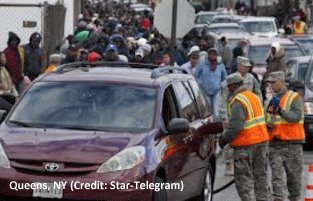Is climate change a real crisis? This is the question many of us have been asking ourselves in the aftermath of Hurricane/Superstorm Sandy. We have had hurricanes in the past. But nothing like Sandy has ever hit New York City. For those of us who have been warning people about climate change to no avail, this superstorm was only proof number 10,000 that climate change is alive and well, and it's something that needs to be taken very seriously. Here’s what happened in my neighborhood of Queens, NY leading up to and throughout Sandy.
Many New Yorkers reveled in the fact that we would now have an excuse to buy out all the shelves in the retail stores. Some of us laughed and mocked newscasters, saying the Sandy hype was just a ploy to keep consumers buying as a way to beef up the lagging economy. Other people piled into the local bars unsure of how many days we would be forced to stay indoors. Particularly those in and close to Long Island who know how fickle the transportation system can be. Let’s face it: the Long Island Rail Road has been known to cause broad and painful service issues with just a sprinkle of rain. Thankful that we in Jamaica, Queens were not in an area that called for immediate evacuation, we finally hunkered down, turned in and awaited the much anticipated storm.
At the peak of the storm, we noticed many down trees, power outages (which would remain for weeks), and heard reports of flooding and even deaths. Yet still for many residents the effects of Sandy was only a minor inconvenience that could be worked around. It was not until bus loads of hundreds of now stranded families began piling into our local schools did we begin to witness first hand the devastation of Sandy. Then came the gas crisis, which turned our neighborhoods into what seemed like a war zone as the national guards retained peace and order at the local gas stations. After all of this mass chaos, did we still think climate change should be taken lightly?
 It’s no secret that in our community the topic of climate change does not come up often. We have bigger fish to fry like stop and frisk policies, immigration reform, or better public schools, the list seems endless. However, whether or not we believe that climate change should be at the forefront of our discussions, it continues to affect us and the impacts are far greater in minority communities.
It’s no secret that in our community the topic of climate change does not come up often. We have bigger fish to fry like stop and frisk policies, immigration reform, or better public schools, the list seems endless. However, whether or not we believe that climate change should be at the forefront of our discussions, it continues to affect us and the impacts are far greater in minority communities.
Rising ocean temperatures and sea levels, caused by increased levels of carbon pollution, make storms like Sandy more powerful and disastrous. As evidenced by the 48 New Yorkers who lost their lives as a result of the storm, and the hundreds of low income and minority families from Far Rockaway who were forced to remain in shelters because they do not have the family or income savings to take refuge in more stable housing. Around 47,000 New York City residents have been reported to have applied for housing assistance from the Federal Emergency Management Agency, FEMA. In addition the New York City Housing Authority, NYCHA has reported even before the storm a rampant mold and moisture problem plaguing its public housing developments. What kind of long term respiratory effects will occur as a result of this?
Here are some interesting facts provided by the Congressional Black Caucus Foundation:
- Asthma will increase because of global climate change and will disproportionately impact African Americans. Over 70 percent of African Americans live in counties in violation of federal air pollution standards.
- African Americans are disproportionately impacted by deaths during heat waves. Urban areas are typically covered in surfaces such as asphalt and concrete, which retain heat. As a result, temperatures in these areas are higher, especially during heat waves. African Americans are more than twice as likely as whites to live in the inner city.
- Unemployment and economic hardship associated with climate change will fall most heavily on the African American community.
 On the flip side, reducing emissions of greenhouse gases to 15 percent below 1990 levels would save an estimated 10,000 African American lives per year by 2020. I think it’s time we begin to recognize the impact of climate change in our communities. Don’t you?
On the flip side, reducing emissions of greenhouse gases to 15 percent below 1990 levels would save an estimated 10,000 African American lives per year by 2020. I think it’s time we begin to recognize the impact of climate change in our communities. Don’t you?


The views and opinions expressed in this post are those of the author(s) and do not necessarily reflect those of MomsRising.org.
MomsRising.org strongly encourages our readers to post comments in response to blog posts. We value diversity of opinions and perspectives. Our goals for this space are to be educational, thought-provoking, and respectful. So we actively moderate comments and we reserve the right to edit or remove comments that undermine these goals. Thanks!